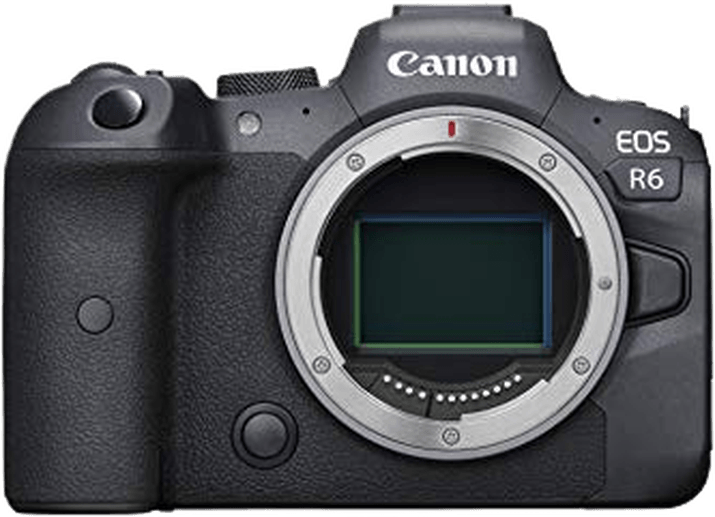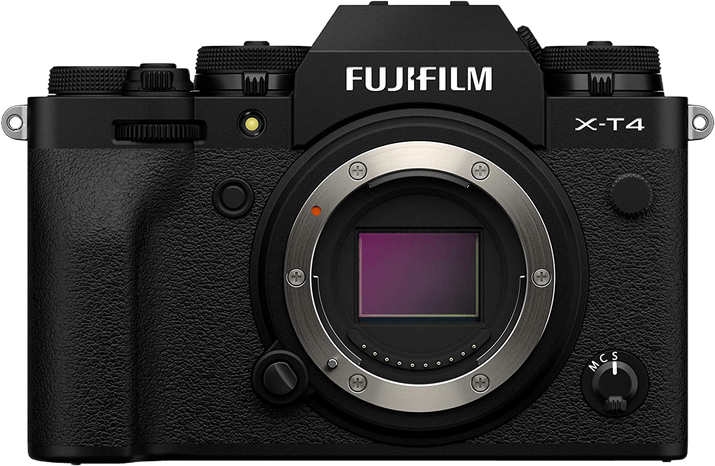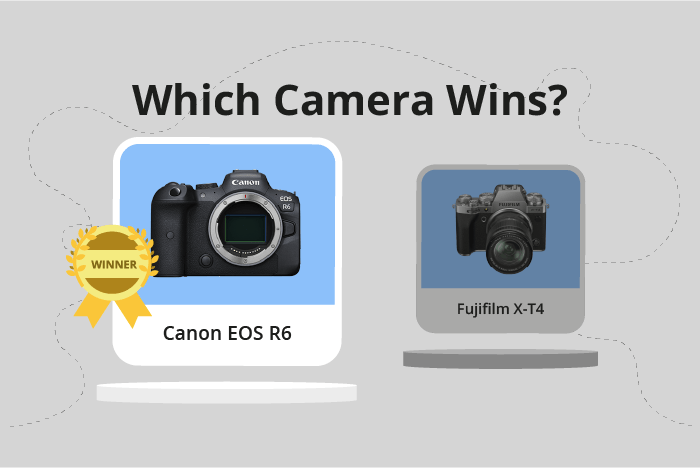Canon EOS R6 vs Fujifilm X-T4 Comparison
Canon EOS R6

Fujifilm X-T4

The Canon EOS R6 takes the lead with a score of 80/100, while the Fujifilm X-T4 trails slightly behind with a 76/100 score. Both cameras are mirrorless and were released in 2020, with the EOS R6 announced on August 27 and the X-T4 on February 26. They share similar dimensions, but the EOS R6 is slightly larger and heavier at 138 x 98 x 88mm and 680g, compared to the X-T4’s 135 x 93 x 84mm and 607g.
The EOS R6’s higher score reflects its superior performance, despite its heftier $2499 launch price. On the other hand, the Fujifilm X-T4 has a more affordable $1699 launch price, offering a lighter and more budget-friendly option without sacrificing too much quality.
Taking all aspects into consideration, the Canon EOS R6 stands out as the better camera, while the Fujifilm X-T4 remains a viable alternative for those seeking a more budget-conscious option.
Canon EOS R6 vs Fujifilm X-T4 Overview and Optics
The Canon EOS R6 outperforms the Fujifilm X-T4 in optics with a score of 79/100, a difference of 6 points from the Fujifilm X-T4’s score of 73/100. Both cameras share some common specifications, such as a 20 frames per second shooting speed, CMOS sensor type, and image stabilisation. However, the Canon EOS R6 has several advantages over the Fujifilm X-T4 that contribute to its higher score.
The EOS R6 features a full-frame sensor, which allows for better image quality and low-light performance compared to the X-T4’s APS-C sensor. Additionally, the Canon EOS R6 has a Digic X processor, which is superior to the X-T4’s X-Processor 4, resulting in faster image processing and improved performance. Furthermore, the EOS R6 has a DXOMARK score of 90 for its sensor, while the Fujifilm X-T4 does not have a DXOMARK score as the company does not evaluate Fujifilm cameras.
Despite having a lower score, the Fujifilm X-T4 does have some advantages over the Canon EOS R6. It has a higher resolution with 26 megapixels compared to the R6’s 20.1 megapixels, which can produce more detailed images. Additionally, the X-T4 uses a Fujifilm X lens mount, which offers a wide variety of lenses for different shooting situations.
Taking these factors into account, the Canon EOS R6 is the superior camera in terms of optics due to its full-frame sensor, better processor, and high DXOMARK score. However, the Fujifilm X-T4 remains a strong contender with its higher resolution and versatile lens mount, making it a suitable choice for those who prioritize image detail and lens variety.
Canon EOS R6 vs Fujifilm X-T4 Video Performance
The Canon EOS R6 and the Fujifilm X-T4 both achieve a video score of 91/100, indicating their strong performance in this area. These cameras share several common video specifications, including 4K maximum video resolution, 120fps maximum video frame rate, and built-in time-lapse functionality.
Despite having the same score, the Canon EOS R6 has some advantages over the Fujifilm X-T4. The R6 features a maximum video resolution of 3840 x 2160, which is sufficient for most users. Additionally, the R6’s 120fps frame rate allows for smooth slow-motion video capture, making it an excellent choice for videographers who prioritize this feature.
On the other hand, the Fujifilm X-T4 boasts a slightly higher maximum video dimension of 4096 x 2160, providing a small advantage in video quality. This larger dimension may be beneficial for those who require the highest possible resolution for their video projects. Similar to the R6, the X-T4 also offers a 120fps frame rate for slow-motion video capture.
Both cameras excel in their video capabilities, with the Canon EOS R6 offering a solid performance that meets the needs of most users. The Fujifilm X-T4, however, provides a slight edge in video quality due to its higher maximum video dimensions. Ultimately, the choice between these two cameras will depend on individual preferences and specific requirements for video projects. While neither camera is decisively superior in terms of video capabilities, both options are powerful tools for videographers and content creators.
Canon EOS R6 vs Fujifilm X-T4 Features and Benefits
The Canon EOS R6 and Fujifilm X-T4 are both excellent cameras with identical feature scores of 85/100. They share several common specifications, including a 3-inch screen size, 1,620,000-dot screen resolution, touchscreen capabilities, flip screens, and no GPS. Additionally, both cameras include WiFi and Bluetooth connectivity.
The Canon EOS R6 stands out for its advantages in certain areas. However, these advantages are not specified, making it difficult to provide a definite reason for its superiority. Despite this, it is important to note that the higher score does not make the camera better, but rather, the camera achieves a higher score because it is better in specific aspects.
On the other hand, the Fujifilm X-T4 also excels in some areas. Again, the exact advantages are not provided, but it is important to acknowledge that the camera’s lower score does not necessarily mean it is inferior. Instead, it has its own unique strengths that contribute to its overall score.
In comparing these two cameras, it is clear that they have many similarities in terms of features and specifications. Both the Canon EOS R6 and Fujifilm X-T4 offer a high-quality user experience, making them strong contenders in the market. While each camera has its own strengths and weaknesses, their identical feature scores of 85/100 demonstrate that they are both top choices for photographers and enthusiasts alike. Ultimately, the decision between the two cameras will depend on individual preferences and specific needs.
Canon EOS R6 vs Fujifilm X-T4 Storage and Battery
The Fujifilm X-T4 outperforms the Canon EOS R6 in storage and battery, scoring 73/100 compared to the R6’s score of 68/100. Both cameras share common specifications, such as two memory card slots, compatibility with SD/SDHC/SDXC (UHS-II) cards, and USB charging capabilities.
The X-T4’s advantage lies in its longer battery life, providing 500 shots per charge, compared to the R6’s 360 shots. This allows for extended shooting sessions without the need for frequent battery replacements or recharging. The X-T4 uses the NP-W235 battery, which contributes to its superior battery performance.
The Canon EOS R6, despite its lower score, still offers a respectable battery life of 360 shots using the LP-E6NH battery. The R6’s storage and battery specifications are sufficient for most users, but the Fujifilm X-T4’s longer battery life gives it a clear edge in this category.
Canon EOS R6 vs Fujifilm X-T4 – Our Verdict
Are you still undecided about which camera is right for you? Have a look at these popular comparisons that feature the Canon EOS R6 or the Fujifilm X-T4:

